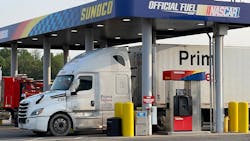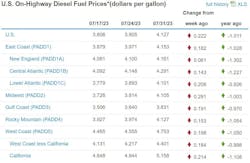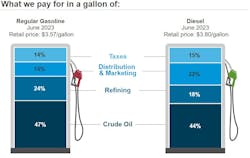U.S. diesel average spikes 22.2 cents, races past $4 per gallon
Diesel fuel in the U.S. broke several barriers for the week of July 31, none of them good for trucking, and most that could bring on leftover post-traumatic stress for fleets and drivers from the record-shattering prices of last summer.
Just when you thought it was safe to fill your rig again:
- The U.S. average climbed 22.2 cents this week, racing past $4 per gallon to $4.127, the highest since March 27, according to the latest data from the U.S. Energy Information Administration (EIA).
- Prices were up by double digits in every region and subregion that EIA measures except for one, New England, where diesel still was up 6.1 cents to well beyond $4 per gallon: $4.161. Diesel was nearly 30 cents higher—29.1 cents per gallon—in the Midwest to $4.105 for the week.
- The gap between the highs of a year ago and this year’s average threatens to shrink below $1 next week if the fuel-price increases continue, as analysts predict they likely will do. Diesel is $1.011 less expensive than one year ago.
- The U.S. diesel average has risen 32.1 cents the past two weeks, following an unexpected 9.9-cent bulge for the week of July 24.
- The national price rose easily the most of 2023. In fact, the week-of-July 31 surge was the largest one-week increase in 16 months.
- Motor club AAA’s U.S. diesel average on Aug. 1 had climbed 17.3 cents over last week to $4.073 per gallon.
If that all wasn’t enough, the national average for gasoline (pumped by some smaller fleets and work truckers) rose by 16.1 cents to $3.757 per gallon for the week of July 31, narrowing the margin for gas significantly from its 2022 highs. Gasoline now is 43.5 cents cheaper than a year ago, and it's up by double digits in every EIA region but the West Coast.
“Gas prices suddenly soared over the last week due to heat-related refinery outages that impacted some of the largest refineries in the country, at a time when summer gasoline demand peaks and as gasoline inventories slid to their lowest July level since 2015,” said GasBuddy head of petroleum analysis Patrick De Haan.
See also: Fleet failures playing role in fueling used-truck market surge
“In addition, oil prices surged to their highest level in months, rising to over $80 per barrel due to [Strategic Petroleum Reserve] releases coming to an end and concerns over cuts in supply from Saudi Arabia and Russia, the second and third largest oil producers in the world. Motorists have seen average gasoline and diesel prices rise at the fastest pace in over a year, but the rise seen in the last week should now start slowing.”
Oil was up on Aug. 1 to new 2023 highs. West Texas Intermediate crude was above $81 per barrel, while Brent crude was nearing $86.
Red up arrows everywhere in the U.S.
The price picture in EIA’s regions and subregions was uglier for the week of July 31 for diesel than the national average, with the Midwest leading the increases.
In the other subregions of the East Coast, where diesel was up 18.2 cents to $4.153 per gallon, the fuel also rose well into the double digits and past $4 per gallon: 20.8 cents in the Lower Atlantic to $4.101 and 14.3 cents in the Central Atlantic to $4.291.
The surge in diesel along the Gulf Coast was the third largest in the nation, 19.1 cents to $3.831 per gallon, in the EIA region where the fuel still is the cheapest. The second largest increase, 19.8 cents to $4.753, occurred in the EIA region where trucking’s main fuel is the most expensive, the West Coast. Diesel surged by 21.4 cents (to $5.158 per gallon) and 18.4 cents (to $4.401) in the West’s two EIA subregions, California itself and the West Coast not including data from California.
The fuel also rose 15.3 cents in the Rocky Mountain region to $4.127 per gallon.
About the Author
Scott Achelpohl
Managing Editor
Scott Achelpohl is a former FleetOwner managing editor who wrote for the publication from 2021 to 2023. Since 2023, he has served as managing editor of Endeavor Business Media's Smart Industry, a FleetOwner affiliate.



